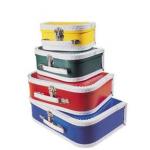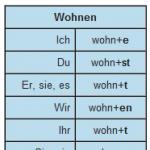Main types of locksmiths works are as follows: metal chopping, metal cutting, manual straightening and bending of parts, filing, hole processing (drilling, countersinking, reaming), manual threading, riveting, scraping, lapping, soldering and tinning.
Rice. 175.

Rice. 176.
Chopping metal is produced manually with a chisel (Fig. 175), hitting it with a hammer (“handbrake”). Cutting out grooves is done with a cross-messel (Fig. 176). Pneumatic chisels are also used to level out uneven surfaces.
cutting metals are produced by hand using hand saws, in which the hacksaw blade is tensioned in the machine using a wing screw. Sheet materials are cut using hand-held metal scissors of various designs.
Edit parts are produced by hand on straightening plates, anvils and mandrels using hammer blows. Bending is done in a cold or hot state in a vice or in special devices.
Filing remove layers of metal up to 2 mm using files. They are divided into basal (for rough filing), personal (for fine filing), and velvet for finishing filing. The length of files varies from 100 to 400 mm. Files can be flat, triangular, square, round, semicircular, etc. There are mechanical files used in metalworking work.


Rice. 177. Drills: manual (a) and electric (b)
Drilling Holes during metalworking are made with hand, electric or pneumatic drills (Fig. 177). When using electric and pneumatic drills, holes with a diameter of up to 25 mm can be drilled.
Countersinking and reaming produced by securing the cutting tool in a crank that is turned manually. Manual reamers come in cylindrical and conical types.
Threading made manually using metalworker's taps and dies. Threading in holes is carried out sequentially with two or three taps placed in the drivers.



Rice. 178. Threaded dies (b and c) and clamps (a)
For manual cutting of external threads, dies are used, which are round (Fig. 178, a) and prismatic. Round dies (solid or split) are secured in die holders (Fig. 178, b). The prismatic die consists of two halves, fixed in the clamp (Fig. 178, c).
Riveting manually produced with cold or heated rivets using hammers and crimps to give the desired shape to the closing head of the rivet.
Scraping produced to ensure a tight fit between the two mating surfaces of the part. The scraping process involves scraping off thin layers of metal with a special tool - a scraper, driven manually or mechanically.
First, unevenness on the surface to be treated is identified. To do this, it is brought into contact with the mating part or with a test plate or mandrel, coated with a thin layer of paint (blue or soot with oil). After mutual movement of the mating surfaces on the one to be processed, the protruding areas of the surface will be painted. In these places, the metal is scraped off with a scraper. This process is repeated repeatedly until the number of stains remaining on the treated surface corresponds to the required number and the distribution of stains over the surface is uniform. The number of spots is determined by counting them when applying a control frame measuring 25x25 mm.
Depending on the nature of the surface being processed, scrapers of various shapes are used (flat, triangular, semicircular, etc.).
Bench grinding There are two types: lapping of mating surfaces with each other and surface treatment with a tool - lapping.
In the first case, the mating surfaces are coated with a mixture of abrasive and oil and moved manually or with a drill relative to each other until the required mating density is achieved.
When processing by lapping, the surface of the part is moved relative to this tool or, conversely, the lapping is relative to the part. The lap surface is coated with a mixture of abrasive and oil or a chemically active liquid.
Lappings made of gray cast iron, bronze, brass, wood. They come in the form of slabs and round cylindrical or conical rolling pins, depending on the shape of the surface being processed.
Manual lapping- a lengthy and expensive process, used only for small production programs.
Metalworking work mainly refers to cold processes. Such processing can be carried out manually or using a special mechanized tool. Such tools are a chisel, a center punch, a hammer, a scraper, guillotine shears, a file and many others.
Metalworking of a metal workpiece is performed in a certain sequence. The first step is to carry out preparatory work on manufacturing the workpiece or changing its shape - straightening, chopping, bending the material. Then the workpiece is marked and its basic processing is carried out: the excess layer of metal is successively removed so that it acquires the dimensions, shape and condition of the surfaces close to those indicated in the drawing. Locksmith tool
Then finishing processing of metal products is carried out, after which the part must meet all the requirements of the drawing.
Plumbing and repair work
There are plumbing and repair work, which consists of replacing or correcting damaged and worn parts, manufacturing missing parts, assembling components, mechanisms and even the whole machine, performing fitting work and adjusting assembled mechanisms and testing the finished machine. Each mechanic has his own workplace - a small section of the production area of the workshop, where there is all the necessary equipment: hand tools for, instrumentation, auxiliary devices.
The main equipment of the workplace for metalworking is a bench with a vice attached to it and a set of necessary working and control tools and devices. In order for the workplace to be able to move parts or components weighing more than 16 kg, it must be serviced by cranes or lifts. To perform assembly or disassembly work, workplaces are equipped with stands, conveyors, roller tables, special carts or other transport devices.
Marking, cutting, straightening and bending
Metalworking includes operations such as marking, chopping, straightening and bending, as well as cutting metal with a hacksaw and scissors, cutting internal or external threads, scraping and joining parts by soldering or gluing.
Marking the workpiece
Marking is the process of applying special lines (marks) to the surface of the workpiece, which, according to the requirements of the drawing, determine the places or contours of the part to be processed. Marking creates the necessary conditions for obtaining a part of a certain shape and required dimensions, removing metal allowance from workpieces to specified limits and for maximum savings in materials. The history of artistic metal processing knows many examples when, with the help of markings and subsequent engraving or notching, real works of art were obtained.
Metal cutting
The cutting process involves removing metal from a workpiece using a chisel and hammer. It is produced in a vice, on an anvil or plate.
Editing and bending of the product
Editing is an operation by which various imperfections in the shape of the workpiece (irregularities, curvature) are eliminated. Manual straightening is done with a hammer on a straightening anvil or plate, and machine straightening is done on straightening machines.
Using bending, the workpiece is given a given shape (in the manufacture of hinges, brackets, rings, brackets and other products). Like any other metal processing, manual bending can be done in a vice using a metalworker’s hammer and various devices. Mechanized bending is carried out on bending machines and bending presses with manual and mechanized drives.
Metal cutting
A special hacksaw or scissors (metal guillotine) can be used to cut metal. Sheet metal is cut with manual or mechanical scissors, pipes, and profile material is cut with manual or mechanical metal hacksaws. Pipe cutters, as well as circular and band saws are used for cutting.
The technique of metal cutting includes an operation such as filing. This process consists of removing a layer of metal from the surface of the workpiece in order to give it more accurate dimensions and the required surface cleanliness. Filing is done with files.
When metalworking metalworking, an operation such as drilling can be performed - producing cylindrical holes using a drill. Drilling can be carried out on many metal-cutting machines: drilling, lathe, turret and others. The most suitable for this operation are drilling machines. During assembly and repair work, drilling is often done using portable drills: pneumatic, electric, etc.
The manufacture of metal parts may include threading - the process of forming spirals on the internal and external cylindrical and conical surfaces of workpieces that serve to connect parts. Such parts form detachable connections. Threads on bolts, screws and other parts are cut mainly on machines. When assembling and repairing units, as well as during installation work, they resort to cutting threads manually using taps and dies.
Technologies for manual metal processing attach great importance to scraping - an operation for processing the surfaces of metal parts, during which a layer of metal is scraped off with a special cutting tool - a scraper. Scraping is used to ensure precise contact of rubbing surfaces without disrupting their lubrication. This operation is performed manually or on special machines.
In metalworking, metal finishing is often accomplished by lapping, which is done using hard grinding powders applied to special laps made of gray, copper, mild steel, and other materials. The shape of the lap must correspond to the shape of the surface being treated. By moving the lap over the surface being processed, a very thin (0.001-0.002 mm) layer of roughness is removed from it, which helps to achieve tight contact of the mating parts.
Permanent connections
To obtain permanent connections from metal parts, metal processing methods such as riveting and soldering are often used. Riveting is a method of obtaining a permanent connection from two or more parts using rivets. Riveting can be done with a pneumatic hammer, a hand hammer or on special riveting machines.
Soldering parts
Soldering is the process of joining metal parts using a molten alloy called solder, which has a melting point much lower than the metal of the parts being joined. Metal processing at home often includes soldering - it is widely used for repair work, as well as for sealing cracks, eliminating liquid leaks from vessels, etc.
When welding high-strength steels, you need to have certain knowledge and skills - this is the only way to achieve success in this matter. You will find interesting information on this issue in our article at the link.
Safety requirements during plumbing work
When performing metalworking work, which is carried out in a production area, and especially when metalworking is carried out at home, the following safety requirements must be observed:
- on the workbench you need to put only those tools and parts that will be necessary to complete this work;
- metalworking of metals should be performed only after they have been securely secured in a vice;
- remove shavings and dust from the workbench only with a brush;
- do not perform drilling work or sharpen tools with bandaged fingers or mittens to avoid them being caught by the drill;
- while the machine is operating, it is prohibited to open or remove protective covers, guards and safety devices;
- when riveting, chopping and other work in which there is a possibility of metal particles flying off, it is necessary to use safety glasses or a mask with safety glasses, while fencing off the workplace with nets and portable shields to avoid injury to people working nearby or passing by;
- pneumatic tools must be used with flexible hoses. It is strictly forbidden to use hoses that are damaged.
The main field of activity of AVEA Technology is the production of metal parts according to customer drawings. We provide a full range of services for metalworking parts in Moscow and the Moscow region. Our certified specialists have many years of experience in manufacturing metal parts on CNC machines to complete orders exactly on time and in accordance with customer requirements, medium and large series.
Metalworking services on CNC machines in Moscow
To produce a series of parts, you may need one or more types of work related to metal processing, such as:
- turning
- processing on turning and milling machines
- milling of metal and plastic
- metalworking
- heat treatment
- application of various types of coatings
- engraving
We subject all our products to a thorough quality control inspection to ensure product quality meets established international standards and the customer’s wishes. This gives us the opportunity to rightfully claim that every part we create fully complies with the requirements, even those necessary in the military sphere.
Metal parts using modern technologies
In our company you can order a full range of works on the production of metal parts. Modern equipment for precision metalworking, our competencies in modern technologies for metal processing allow us to create parts with high quality, excellent efficiency and at attractive prices.
A distinctive feature of AVEA TECHNOLOGY is its concern for the efficiency of your business. In addition to custom metalworking, we can help in the field of import substitution - with the help of technological developments and business connections of our company, you can get rid of purchases in foreign currency.
We are also ready to offer you cooperation in the field of reverse engineering. We can produce parts according to a sample - starting from a product drawing and ending with mass production of a batch.
Providing a full range of metal processing services using modern equipment in Moscow and the Moscow region is fast, convenient and profitable for every AVEA TECHNOLOGY customer.
Locksmith work
To a person who has never worked with metal before, it may at first glance seem that you will never master metalworking skills without studying for several years at a technical school or at least at a vocational school. However, in reality, everything is not so complicated: almost anyone who has a desire to work with their hands and head, and not run to a specialized workshop with every minor breakdown, can learn plumbing within the limits necessary for home work. Only the first step is difficult, therefore, having learned how to eliminate small faults, you can understand larger and more complex ones.
What qualities should a locksmith have? Precision, precision and precision again. For any of the metalwork operations: marking or chopping metal, filing or drilling, threading or soldering require precision execution, since an error of just 1 mm can lead to damage to the workpiece.
What should a locksmith first of all know and be able to do? Of course, metal processing techniques that allow him to bring the quality of the plumbing work he performs to the required level. Of course, we are not talking about an industrial-style lathe or milling machine; the home craftsman makes do with manual metal processing techniques. Although those who have the opportunity to set up a small workshop at home, as a rule, install small (household) machines.
This text is an introductory fragment. From the author's bookRestoration work Before undertaking restoration work, a home craftsman should weigh his real capabilities and try to eliminate existing gaps in knowledge. It would be useful not only to read specialized literature, but also to obtain
From the author's book2.8.1. Principle of operation The device operates on the principle of destroying insects with a high voltage electric discharge. It is not dangerous for humans (although noticeable) due to the very small (units of µA) current. In case of accidental exposure to a person (touching the grid with electrodes when
From the author's bookMeasuring locksmith tools Measuring tools (Fig. 1) are usually the subject of special concern for a mechanic, since the result of work often depends on whether they are in good condition for more than one day. Rice. 1. Measuring tools: a –
From the author's bookGeneral purpose metalworking tools This rather large group combines metalworking tools and devices for performing various operations on metal or metal workpieces. For precise positioning of the workpiece and ease of execution
From the author's bookOrganization of work Before performing work, you must first of all master the technique of applying certain types of threads to the surface of products. The relief and configuration of the pattern (Fig. 147) depend on the thickness of the circle used in the work, as well as on the angle at which
From the author's bookOrganization of work Work on making drawings using the matte engraving method is carried out using a special machine, on which, in addition to copper wheels for engraving, holders are also installed on which additional abrasive wheels are attached,
From the author's bookOrganization of work The configuration of the lines applied to the surface of the glass product depends on the selected abrasive wheel. Before you start working, you need to master the technique of executing a particular line: – straight, flat lines are applied to the surface using
From the author's bookOrganization of work To apply jagged sparkling edges to the surface of glass products, a regular diamond glass cutter is often used. When working, you need to hold it in your hand like a fountain pen. With the help of such a cutter you can create a wide variety of lines. Thin
From the author's bookOrganization of work Sheet glass, as well as all kinds of glass products of especially large sizes, can be decorated with a pattern, for the application of which a drill with abrasive tips is used. Instead of a drill, a mechanism consisting of
From the author's bookOperating modes The device can distinguish four operating modes: TA charge; storage mode; TA discharge – engine heating; interior heating. Charging TA. Obviously, before using the device to heat the engine, its TA must be filled with hot
From the author's book3.2.1. Excavation work Securing power transmission line supports can be carried out either by directly burying them in the ground or using various types of foundations, the most common of which are reinforced concrete prefabricated foundations,
From the author's book2.1.4. Mechanical and lubrication work Question 33. What are the requirements for removing parts, assemblies and assemblies from the vehicle and installing parts, assemblies and assemblies on it? Answer. Parts, assemblies and assemblies removed from the vehicle should be installed on special stable stands, and long parts - on racks.
TO category:
Locksmith work - general
Types of plumbing work and scope of plumbing work
Metalworking work usually refers to the processing of metals in a cold state, performed by mechanics manually using various tools.
Metalworking work consists of a variety of technological operations, which include: marking, chopping, straightening and bending metals, cutting metals with a hacksaw and scissors, filing metal, drilling, countersinking and reaming, threading, riveting, scraping, lapping and finishing, soldering, tinning etc. Some of the listed operations can also be performed when metals are hot (for example, chopping, bending, riveting). Many locksmith operations can be performed not only manually, but also mechanically.
When manufacturing or processing metal products using metalworking methods, the most important metalworking operations are performed in a certain order. Their purpose is to give a piece of metal (blank) the shape, size and surface condition that the finished product should have, according to the drawing.
First, metalworking operations are performed to manufacture or correct the workpiece (cutting, straightening, bending); they can be called preparatory. Next, the main processing of the workpiece is performed, which in most cases consists of cutting and filing operations; As a result of processing, excess layers of metal are removed from the workpiece and it receives a shape, size and surface condition that are close to or coinciding with those indicated in the drawing. There may be products for the manufacture of which additional operations of scraping, grinding, lapping, and finishing are required, which make it possible to remove the last, very thin layers of metal from the product being manufactured; After this, the manufactured products take on their final dimensions and appearance.
In addition, parts can be connected to others, for which the operations of drilling, countersinking, threading, riveting, and soldering are performed. These operations are usually performed after the main machining has been completed, but before grinding, lapping and finishing.
Depending on the requirements for the finished product, additional operations may also be performed; their purpose is to give the metal from which the product is made new properties: increased hardness or toughness, resistance to destruction - corrosion. Such operations include tinning, hardening, carburizing, electric surfacing, etc.
Depending on the form in which the product arrives for processing, some operations may not be performed at all; however, the mutual connection and sequence of operations performed is not disrupted: coarser processing always precedes finer processing.
Locksmith work is found in all industries and especially in mechanical engineering, where they are very diverse both in nature and in complexity.
In enterprises or workshops that produce heterogeneous products in small quantities (individual production), mechanics are required to be versatile. A mechanic working at such an enterprise performs a variety of jobs of varying complexity and accuracy. He makes tools, fixtures and individual parts from start to finish, fits the parts to each other and assembles them into products; if necessary, solders, tins, repairs machines, machine tools and other equipment. Custom manufacturing businesses involve a lot of manual work, and mechanics make up the bulk of the workforce.
There is a significant share of manual work in mass production enterprises, where identical products are produced in periodically repeating batches or series. Here, qualified mechanics perform manual work, much of which cannot yet be replaced by machine work, such as assembly.
These enterprises employ fitters, fitters, fitters, tool makers, repairmen, etc. Their work continues to be necessary even in mass production enterprises, where products are produced in large quantities and mechanized methods of work are most widely used.
Enterprises of all types listed above have repair shops; here mechanics are divided into teams according to types or groups of equipment.
At machine repair factories and repair shops of all kinds, the main work is performed by mechanics. At these factories and workshops, fitters, assemblers, tool makers, etc. make up the main cadre of workers.
Finally, in enterprises of all types, mechanics are needed to install industrial steam pipelines and heating systems, as well as to perform water, gas, and sanitary work.
From the above we can conclude that in any industry or farm where there are machines, mechanisms, devices and various devices made of metal, the work of a mechanic is necessary.
Mastering the qualifications of a mechanic is very important for increasing the productivity of workers in many specialties. When working with metal and machines, there is a constant need to use such metalworking operations as straightening, cutting and chopping metals, threading, soldering, lapping and fitting parts, as well as the ability to make and restore working tools.
The study of plumbing is necessary for agricultural machine operators - tractor drivers, combine operators, as well as machine operators in road construction, fitters of various specialties, car drivers, etc.
Tractor drivers, combine operators, crane operators, and drivers who have studied plumbing can set up machines faster and better, eliminate and prevent all kinds of downtime, and independently repair serviced mechanisms.




